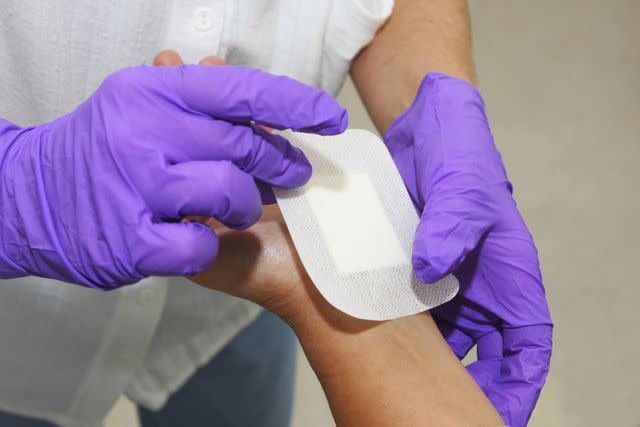Pillar Pain and Other Complications of Carpal Tunnel Surgery

Medically reviewed by Stuart Hershman, MD
Surgery is a common treatment for carpal tunnel syndrome, a condition that occurs when the median nerve, which travels from the forearm to the palm of the hand, becomes pressed or squeezed. Surgery can either be traditional open surgery or endoscopic minimally invasive surgery.
There are possible complications from this surgery, including what’s known as pillar pain. Pillar pain occurs on the sides of the surgical incision in the palm. It is also possible to experience numbness and tingling, nerve problems, and incision pain after surgery.
While the chance of experiencing complications is small, patients should understand these possible risks. This article will cover some of the common complications of both types of carpal tunnel surgery.
Incision Pain and Pillar Pain
Two types of pain may occur in the palm after carpal tunnel surgery: incisional pain and pillar pain. Pain around the incision site is more common after traditional open surgery than endoscopic carpal tunnel release.
Incision pain typically only lasts for a few days or weeks after surgery. You can lessen or prevent pain by protecting the incision and avoiding lifting or gripping for several weeks after surgery.
Pillar pain occurs to the sides of the incision in the thicker parts of the palm, called the thenar and hypothenar eminence. This is where the transverse ligament attaches to the carpal bones (forming the carpal tunnel). The muscles of the palm are also located here.
Pillar pain is the more common and troublesome complication of carpal tunnel surgery and may take several months to resolve.
Treatments for pillar pain may include rest, massage, and hand therapy.
Persistent Numbness and Tingling

BURGER / PHANIE / Getty Images
There are two reasons why people may feel numbness and tingling after carpal tunnel surgery. One is that the carpal ligament is not completely released. This can lead to persistent compression on the median nerve and, therefore, persistent symptoms. This complication is more common with endoscopic carpal tunnel surgery.
The second reason is nerve damage from long-standing compression to the median nerve. Some people who have had carpal tunnel syndrome for a long time may have persistent numbness and tingling even after surgery. Sometimes nerve damage is so severe that sensation is never restored to normal.
A nerve test called an electromyography (EMG) study can help indicate the severity of nerve compression before surgery.
Infection

bojan fatur / Getty Images
Infection is an uncommon complication but still possible after either open or endoscopic carpal tunnel surgery. It is important to follow your surgeon's instructions carefully to ensure that you're taking proper care of the incision area. There are steps you can take to help prevent the possibility of infection.
While some surgeons may prescribe antibiotics, they are not routinely needed for carpal tunnel surgery. If an infection does occur, antibiotics can be an effective treatment. Occasionally, additional surgery is needed to clean out the infection from the surgical wound.
Nerve Injury

Echo / Getty Images
Injury to the median nerve or its branches is uncommon during carpal tunnel surgery but it can happen.
The chance of a nerve injury is slightly higher with endoscopic carpal tunnel surgery but still very rare. In one study involving patients who underwent endoscopic carpal tunnel surgery, the median nerve was injured in only two of 694 (0.29%) hands.
If this injury happens, it typically affects a small branch of the nerve that either controls the thumb muscles (the motor branch) or the sensation of the palm (the palmar cutaneous branch). Symptoms can include pain, numbness, and weakness.
Often, an injury to the nerve is treatable. If the nerve injury is not too severe, the nerve may be able to heal itself, usually within about three months. Physical therapy with methods like electric stimulation can be useful in keeping the surrounding muscles strong while the nerve heals.
If a nerve injury is severe or fails to heal on its own, it may be surgically repaired. The surgical procedure needs to be done as soon as possible and no more than six months after the initial surgery that caused the damage.
Though permanent nerve damage is rare, research has shown an increased risk of permanent damage if the revision surgery is delayed more than six months. This is because a severe nerve injury can lead to the progressive death of nerve cells if the nerve is not repaired promptly.
Recurrent Carpal Tunnel Syndrome

Marcela Barsse / Getty Images
It is possible to have recurrent symptoms after carpal tunnel surgery. This happens about 10% to 15% of the time.
This problem may be addressed with another surgical procedure. But the second surgery may be even less effective than the initial surgery.
Summary
Carpal tunnel surgery is very safe and effective in treating carpal tunnel syndrome. However, as with any invasive treatment, there are risks to this procedure. Some of these include numbness and tingling, pillar pain, infection, and nerve injury. Even though these complications are rare, patients should understand the possible risks of this treatment.

